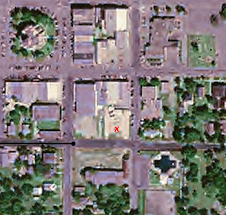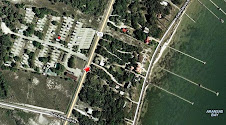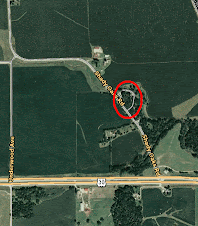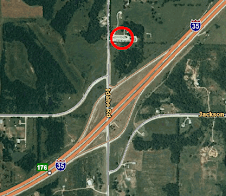Border
“wars” were not just between Missouri and Kansas. In the late
1830s, Missouri claimed a strip of land nearly 13 miles into what
many settlers considered Iowa territory. When Missouri tax collectors
cut down valuable bee trees as payment for taxes that the settlers
htad refused to pay, more than 1,200 Iowans lined up along the
disputed border with pitchforks for revenge. Today, bee trees might
not seem worth fighting for, but sugar was scarce and the settlers
relied on honey. The
trees were valuable both for the honey, which sold for up to 37 cents
a gallon, and for beeswax, which was used in a variety of ways,
including candles.
Taking a supply of honey was almost a bad as stealing a horse.
In
1816, Col John C. Sullivan was one of several surveyors tasked with
surveying the Louisiana Purchase. Sullivan was to survey and mark
the boundaries of the Osage Indian lands (Missouri). His survey was
to be a "parallel of latitude which passes through the rapids of
the river Des Moines.” In error, he did not adjust his compass as
he moved east from the Missouri River. By the time he reached the
Mississippi River he had an angled boundary line 4 miles too far
north.
This
would not become important until people started moving onto the land
in the late 1830s. By this time the marks of the old Indian boundary
(Sullivan line) could scarcely be found; settlers in the area did
not know whether they lived in Iowa or Missouri. This became
significant as the Civil War approached, Missouri was a slave state,
Iowa would be a free state.
When
Missouri wrote its constitution in 1821, it described the state's
northern boundary as "the rapids of the river Des Moines”.
Problem: State and federal governments could not agree on where "the
rapids of the river Des Moines" really were.
Missouri
officials believed that the Des Moines rapids were much farther north
than the Sullivan line and sent Joseph Brown to re-survey the
boundary line in 1837. He was supposed to begin at "the rapids
of the river Des Moines" and then mark his line as he moved
westward to the Missouri River. He found a place on the Des Moines
River which he thought fit the description. Another mistake!
Brown,
like everyone else, assumed the Des Moines Rapids that Sullivan
documented in his survey lines were rapids located in the Des Moines
River. In reality, these rapids were in the Mississippi River.
Setters had dubbed a stretch of the Mississippi as "Des Moines
rapids" at a point where the river dropped 23 feet over a
22-mile span near the point where the Des Moines River emptied into
the Mississippi.
The difference
between the Brown and the Sullivan lines was about 2,600 acres of
rich farm land which officials from both Missouri and Iowa Territory
claimed. Most of the settlers living on the strip thought they had
settled in the Iowa territory.
In
1838, Maj. Albert Lea, a federal surveyor, laid out four possible
boundary lines, all representing different interpretations of
historical data.
Missouri
Gov. Lilburn Boggs was an argumentative sort and proclaimed in August
1839, that Brown's 1837 boundary, the northernmost line, was the
state line. Almost immediately, Iowa Gov. Robert Lucas authorized
the arrest of anyone trying to exercise authority in what he called
"the seat of excitement."
So, in 1839
when Missouri sheriffs tried to collect taxes from settlers in what
is now the southern part of Davis and Van Buren Counties (Iowa); the
settlers refused to pay and appealed to the Iowa Territorial
Governor. Lucas warned the Missouri Governor that Missouri sheriffs
would not be permitted to collect taxes. Governor Boggs warned
Governor Lucas that the Missouri militia might be brought out to make
sure the taxes were collected.
Enter the bee
trees! In the disputed region there were several bee trees the Iowa
settlers valued because of the honey stored in the hollow trunks.
When a Missourian chopped down 3 of these trees the quarrel grew. An
Iowa officer tried to arrest the man but he escaped back Missouri.
That
inflamed Missourians, who have never been reluctant to butt heads
over real or imagined wrongs. Missouri had been a state since 1821.
Iowa Territory was about to become one, so the legal boundary between
the two was an issue.
The Honey War
is underway!
Shortly after
the bee trees had been chopped down, the sheriff of Van Buren County,
Iowa, arrested Uriah Gregory, the sheriff of Clark County, Missouri,
when he tried to collect taxes. This angered the folks in Lewis and
Clark Counties in Missouri and the Missouri militia began to
assemble. Soon a thousand or more men were in camp at Waterloo, MO,
ready to invade Iowa that cold December day of 1839.
Governor Lucas
had been through a similar dispute with Michigan when he was governor
of Ohio. He sent a US Marshal into Van Buren County to take charge.
Lucas insisted the quarrel was not between Missouri and Iowa, but
between Missouri and the United States, since Iowa was still a
territory. If the Missouri started a war about the location of the
boundary, they would be fighting the United States, not Iowa.
Governor
Lucas ordered the officers of the territorial militia to call out
their men and meet at Farmington, on the border just north of
Waterloo, MO. More than a thousand Iowans answered the call, coming
from all over the territory, not just the disputed strip. As troops
gathered from both sides, people began to think that there might
really be war between Iowa and Missouri. The Supreme Court got the
case while the 2 armies were forming.
They must have
been an odd looking bunch. Each man wore whatever he had that
resembled a uniform and brought their own weapon. There were rifles,
muskets, shotguns, pistols, long swords, short swords and rakes and
pitch forks. Stories tell of someone even showing up with a sausage
grinder to use as a weapon. I don't even want to visualize that
scenario!
When the
commander of the Iowa troops at Farmington sent a peace delegation to
Waterloo, they found the Missouri troops had already gone home. There
was nothing left for the Iowa soldiers to do but to go home. Before
all had time to gather, the "war" was over.
In 1849 the
Supreme Court decided that the old Sullivan line was the true
boundary because it had been used so often in treaties. The
surveyors were ordered to remark the line. They searched for days
before finding the blazed tree that marked the original northwestern
corner of Missouri, now a decaying tree trunk. The surveyors ran the
line west to the Missouri River and east to the Des Moines River from
that point. Cast iron monuments, each weighing about 1,600 pounds,
were placed at the east and west ends of the line. Smaller iron posts
were placed every 10 miles and wooden posts placed every mile along
the boundary line.
When their
work was completed and accepted by the Supreme Court, the
Iowa-Missouri boundary dispute came to an end.
One more
survey was done in 1896 at the request of the United States Supreme
Court.






















































